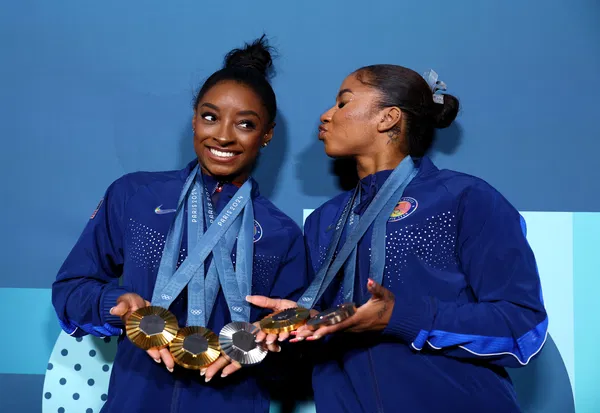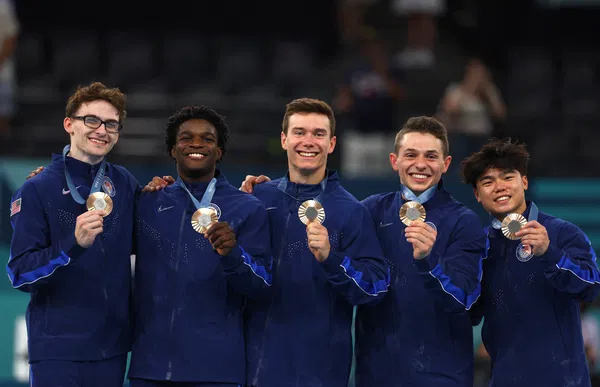
Fred Richard vividly remembers seeing photos of past Olympic medal-winning U.S. men’s gymnastics teams at his gym. Those images fueled his dream: “What if I became one of them one day?” Fast forward to the Paris 2024 Olympics—he did just that. Alongside Brody Malone, Stephen Nedoroscik, Asher Hong, and Paul Juda, Richard helped end a 16-year medal drought by leading the U.S. men’s artistic gymnastics team to a bronze medal. It was their first Olympic podium finish since the 2008 Beijing Games. But this wasn’t just a win—it was a statement. Their performance electrified the arena and etched their names into American gymnastics history.
On the women’s side, Simone Biles and her teammates took things a step further. After narrowly missing out on gold in Tokyo 2021, Biles led a powerhouse team—including Jordan Chiles, Suni Lee, Jade Carey, and rising talent Hezly Rivera—to a triumphant gold medal in Paris. The victory was more than redemption—it was a defiant return to dominance, reminiscent of their performance in Rio 2016. As both the men’s and women’s teams achieved major successes, a new idea began to gather momentum—what if the next breakthrough wasn’t about one gender, but both?
It’s official: there will be a mixed gender team event for artistic gymnastics at the #LA28 Games!
What do you think of this addition to the Olympic program!?
Read more: https://t.co/ct6wOK1hLI pic.twitter.com/wECEKVTu9l
— Gymnastics Now (@Gymnastics_Now) April 9, 2025
That concept—men and women competing on the same team in artistic gymnastics—had been discussed quietly in the background. Many dismissed it as a novelty or a publicity stunt. But then, on April 9, 2025, the gymnastics world received groundbreaking news: a mixed-gender team event would be added to the gymnastics competition for the LA 2028 Olympic Games. This wasn’t going to be an exhibition or a one-off. It would be an official Olympic event with real medals and real stakes. Governing bodies, broadcasters, and athletes all gave their approval, signaling a major shift in how the sport is structured.
The International Olympic Committee explained that gender equality played a major role in updating the Olympic program. Out of 351 events scheduled for LA 2028, 25 are mixed-gender competitions. This includes the new gymnastics team event, joining a list that represents a broader movement toward inclusion and balance in sport.

The timing couldn’t be better for Team USA. With a strong roster on both the men’s and women’s sides, this mixed format opens up new possibilities. Imagine Simone Biles performing her signature skills on floor or beam, then Fred Richard following with a standout high bar routine. Combine that with the reliability and flair of gymnasts like Jordan Chiles, Suni Lee, Paul Juda, and Brody Malone, and the U.S. might have an unbeatable lineup. While the exact rules, format, and scoring structure of the event haven’t been released yet, the potential is already generating huge excitement.
This development is especially significant for the U.S. men’s team. Despite individual successes, they’ve long been in the shadow of their female counterparts when it comes to Olympic medals. The mixed event could allow them to share in that spotlight more fully, possibly contributing to a team gold on home soil. It’s being viewed as a strategic turning point, especially with stars like Biles and Richard possibly leading the charge.
Simone Biles hasn’t committed to competing in LA 2028—but she hasn’t ruled it out either. In a July 2024 interview, she left the door open, saying, “I would never say never… but right now, I can’t tell you yes or no.” Her uncertain but hopeful response left fans with a glimmer of possibility. If she does return, it would not just be a continuation of her legendary career—it could be a full-circle moment.
The significance runs even deeper when you consider Olympic history. The last time the Games were held in Los Angeles was 1984, when the U.S. men’s gymnastics team shocked the world by winning its first—and only—team gold medal. That triumph has remained a high point for the program for over four decades.
Now, 44 years later, another opportunity presents itself. With the addition of the mixed-gender team event, there’s potential for a new chapter to be written. Simone Biles is already the only active gymnast who has been part of two different gold medal-winning U.S. women’s teams (Rio 2016 and Paris 2024). If she competes again in 2028 and helps the U.S. win in this new format, her legacy would reach even greater heights.
With names like Simone, Fred, Suni, Brody, Jordan, and Asher all in the mix, the U.S. could form a truly iconic team. This isn’t just about medals anymore—it’s about rewriting what’s possible in the sport of gymnastics.
And who knows? The echoes of that golden summer in 1984 might just find a new rhythm in Los Angeles 2028—with a modern, mixed-gender twist.